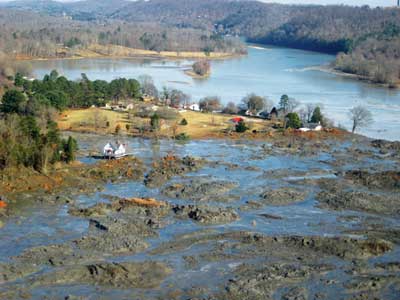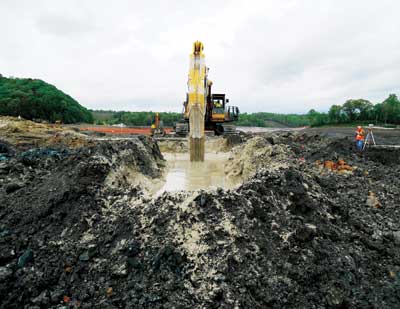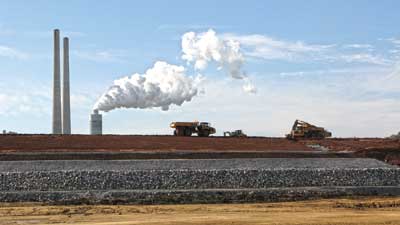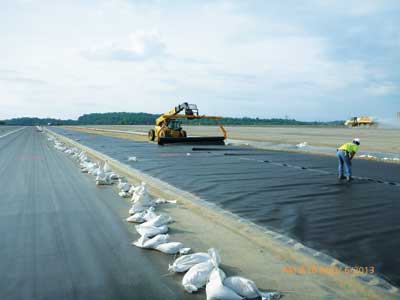
 |
| On Dec. 22, 2008, more than 1 billion gallons of coal ash slurry spilled from a storage pond at TVA's Kingston Power plant. The spill damaged 40 homes and tilled the Emory River. Photo courtesy of Stantec |
A Look at the Engineering Challenges of the Cleanup and Closure of the Failed Ash Dredge Cell in Tennessee
By Alan F. Rauch, PhD, PE, Stantec
On Dec. 22, 2008, about 5.4 million cubic yards of coal ash were released at Tennessee Valley Authority's Kingston Fossil Plant. The spilled ash covered nearly 300 acres, closed the rail line that supplies coal to the power plant, damaged a portion of a public road, and blocked the Emory River. The Kingston incident made news around the world.
Testifying to the U.S. Senate on Jan. 8, 2009, Tom Kilgore, TVA's then President and CEO committed to "… a first-rate job of containment and remediation of the problems caused by the spill. We are going to be able to look our neighbors in the eye and say that TVA is doing the right thing."
Five years later, the cleanup from the ash spill is nearing completion. TVA, in consultation with the U.S. Environmental Protection Agency (EPA) and the Tennessee Department of Environment and Conservation (TDEC), organized a massive effort to recover the released material. Some of the spilled ash was shipped to an off-site landfill, while the rest is being stacked and capped back inside the old site footprint. The perimeter has been reinforced with a buried retaining wall system, which is designed to withstand an earthquake.
Craig Zeller, EPA's project manager at the site, sees how far the cleanup project has come. "It was a daunting project at the start. But five years later, after dredging, digging, and stacking ash day after day, week after week, the end is in sight. The project is on schedule. Ash is out of the river. The perimeter walls are done. The environmental restoration is underway. Kingston is a fantastic case study for a large-scale cleanup," Zeller says. "To finish the job, the engineering team overcame a host of technical, construction, and management challenges."
About 30 miles west of Knoxville, Tenn., TVA's Kingston Fossil Plant was completed in 1955. The facility was built at the confluence of the Emory and Clinch Rivers, within the reservoir formed by Watts Bar Dam. At peak capacity, the 1400-MW generating station produces about 1,000 tons of coal ash per day. Since the 1950s, coal combustion residuals were stored in ponds formed by dikes built across the Emory River embayment. Over the years, TVA expanded the capacity of the ash ponds by raising the perimeter dikes. Accumulated material was also dredged for placement in higher cells. By 2008, ash was stacked nearly 80 feet above the river surface.
In the weeks immediately following the ash spill, TVA focused on providing relief for the affected residents, re-opening the railway, rebuilding the public road, and impeding the downriver movement of ash. Efforts were also initiated to stabilize the site. The steep, 60-foot high scarp at the head of the failure was knocked down. A large-scale, dust control program was organized, initially using helicopters to spread mulch on areas too soft to access. Material flowing out of the failed cell had impacted the dikes that form the adjacent ash pond; over the next two years, the mile-long outer dikes were reinforced with a rock buttress.
 |
| Cement-bentonite walls were built using slurry trench methods. Photo courtesy of Stantec |
Dredging of ash in the main channel of the Emory River started in January 2009, and was completed by May 2010. The recovered slurry of ash was routed through a series of trenches for dewatering, then mechanically stacked and turned to promote drying. Lacking space to temporarily store this material, the ash was loaded into rail cars and transported to an EPA-approved solid waste landfill in Perry County, Alabama. The last shipment left Kingston in December 2010.
TVA retained AECOM to investigate the root causes of the failure. Their report, published in June 2009, concluded that static liquefaction in the ash was triggered by creep strains in a thin, stratified layer of ash and clay at the base of the dredge cell. This and other contributing factors had to be addressed in the plan for final closure of the site.
Plans for the site restoration were developed and implemented in close coordination with state and federal regulatory agencies. In May 2009, TVA and EPA placed the project under the regulatory framework of the Comprehensive Environmental Response, Compensation, and Liability Act of 1980. The CERCLA program was adopted because it promotes a rational, comprehensive process to assess human health and ecological risks, and has been successful in other, complex environmental cleanups. However, TVA did not receive outside funding under the CERCLA program.
With ash recovery and rail shipments underway in 2009, the project team focused on developing plans for the site closure. An aggressive project schedule was established. The engineering problems were technically difficult but economical solutions were needed quickly. To supplement their internal resources, TVA engaged Jacobs to manage construction and site activities. Stantec was tasked with developing the closure design. In all phases of the work, TVA committed to meeting current engineering and regulatory design standards.
Various facility options, configurations, geometries, and heights were evaluated within the CERCLA framework. Removal of all ash from the site would have been prohibitively expensive. The project needed an approach to safely and securely stack the recovered material back inside the old footprint.
 |
| Cement-bentonite walls and rock buttress designed to contain the ash landfill in an earthquake. Photo courtesy of Stantec |
The idea of placing large volumes of ash back within the failed area was met with skepticism. To prove that it could be done without causing another failure, a test embankment was built across six acres of the failed dredge cell in 2009 and 2010. Geotechnical instrumentation was installed to measure water pressures and movements within the underlying ash. Stantec established criteria and carefully monitored conditions. In the end, more than 250,000 cubic yards of ash were safely stacked to a height of 45 feet above the failed surface. In addition to restoring confidence, the test program established protocols that would be followed throughout the project.
TVA decided to install a dry ash handling system at Kingston. The ash pond, which directly abuts the failed cell, was then included in the site closure. By filling the ash pond, the final height of the ash embankment could be reduced significantly. When complete, the crest of the closed landfill will be about 30 feet lower than the dredge cell at the time of the failure.
By early 2010, the closure plan had been divided into three components: perimeter stabilization, ash stacking, and final cover. The project was further broken into 13 design packages, each one to be submitted for independent technical review and regulatory approval. The work was sequenced so that construction could be pushed forward concurrent with design efforts on succeeding segments.
By far, the most difficult design challenge was how to contain the ash in the event of a large earthquake. Tennessee regulations require landfill facilities to withstand a 2,500-year earthquake. Kingston is subject to strong ground motions from local seismic events and large-magnitude earthquakes in far western Tennessee. Engineering analyses showed that these events would liquefy the saturated ash deposits that will remain at the bottom of the closed cell. Moreover, the entire facility is underlain by 10 to 20 feet of liquefiable, alluvial sands.
To achieve seismic stability, Stantec designed a buried retaining wall system that encircles the closed ash cell. Evenly spaced shear walls are oriented perpendicular to the landfill perimeter; in an earthquake, these walls will transfer the outward lateral thrust from the ash embankment to the underlying bedrock. Critical segments also include circumferential walls on the ends of the shear walls. Around the two-mile perimeter, the stabilized width varies between 50 and 100 feet, and the shear walls are spaced between 14.6 and 20.4 feet apart.
Advanced engineering analyses, including both dynamic numerical analyses and 3D structural analyses, were used to evaluate the seismic performance of the wall system. The design was subjected to intense technical review. GEI provided independent peer review of all calculations and design documents. Input was also received from other technical organizations involved in the project, including TVA's Independent Review Board.
The bid specifications assumed the walls would be built using deep mixing, but were written to encourage proposals for alternative construction methods. The winning contractor (Geo-Con) proposed cement-bentonite walls. As each wall panel is excavated to depth, the trench is kept full of thick slurry, which supports the sides of the excavation. The slurry is 20 to 25 percent ground blast furnace slag, and hardens in place to form the completed walls. The walls are unreinforced, with a specified unconfined compressive strength of 200 psi or 265 psi, depending on the section.
 |
| New peremeter containment in the area of the 2008 breach at TVA's Kingston Power Plant. Photo courtesy of Stantec |
In the summer of 2011, Geo-Con mobilized two high-capacity, long-reach hydraulic excavators to the site for perimeter construction. The excavated trenches were four feet wide, and reached depths between 40 and 70 feet. Each wall panel was socketed into bedrock to a depth of 1.8 to 6.9 feet, depending on the location. Geo-Con installed ripper teeth on the back of the excavator buckets to dig into bedrock.
Around much of the site perimeter, the soft, wet ash surface created difficulties for construction. Slurry levels in the trenches must be kept above groundwater levels, to prevent collapse of the trench sidewalls. Along the western side of the site, water percolating from the adjacent ridge charges the deeper alluvium. In places, artesian water pressures were measured. Trench collapse was frequent during the wall excavations along this segment. Here and elsewhere, a deep well dewatering system was required to successfully overcome these difficult conditions.
A comprehensive quality control program was implemented to verify the constructed conditions. Coring was used to check for uniformity and defects within the cured walls. Core samples were tested for strength, but coring can easily damage 200-psi material. Mostly, strengths were measured using cured samples of wet slurry that were collected from the constructed trenches.
The stabilized perimeter was designed and built in eight segments. The engineering work was sequenced so that completed design packages were approved just in time for construction. Significant schedule float between design and construction was not realized until the perimeter design was about half complete. Stantec then organized a value engineering workshop with outside experts to look for ways to further economize the design. The 2012 workshop led to changes in the wall layout and the design strength of the wall, both of which could be implemented without sacrificing seismic performance. The results yielded significant reductions in the wall quantities.
TVA excavated spilled ash from the river, embayments, and surrounding land from January 2009 through June 2013. Prior to stacking, wet ash had to be dewatered and dried to a moisture content less than about 25 percent, a formidable task given the large volumes of material. Ash was moved through a sequence of piles to promote drainage and evaporation. Millions of cubic yards were handled, often moved three or more times. During the winter, when evaporation was ineffective, lime was added to moisture condition the ash.
Earthwork operations were accomplished by TVA's Site Construction Services, using an ever changing fleet of low ground-pressure dozers, hydraulic excavators, off-road trucks, and scrapers. Water trucks were used to control dust across the site; in some areas, exposed ash surfaces were seeded with a commercial erosion control product.
The landfill facility was built under engineering controls. The ash was spread in lifts of about 16 inches and compacted with dozers and smooth-drum rollers. Density tests were used to confirm that the specified compaction had been achieved.
Across the Kingston site, the rate of embankment construction was much higher than typically experienced in routine handling of coal ash. In about five years, several million cubic yards of ash were placed and compacted across the site. Up to 35 feet of material was stacked within the area of the 2008 failure and across the former ash pond. In several areas, large embankments were built prior to completing the walls in the stabilized perimeter.
 |
| The ash landfill was capped with a geomembrane. Photo courtesy of Stantec |
TVA maintained a sustained focus on stability and safety during stacking operations. Over 200 geotechnical instruments were used to monitor subsurface water pressures and displacements. A few challenges occurred on the eastern side of the site, where ash was being stacked across the soft sediments in the former ash pond. Conditions usually improved within a few weeks as high groundwater pressures dissipated. In some cases, the surface geometry was graded to flatten or buttress the slopes and improve stability.
In summer 2013, work began on the final cap and cover. As ash stacking continued elsewhere on the site, the cap contractor (Phillips & Jordan) began deploying a 40-mil thick flexible membrane liner over the ash. The cap system includes a geocomposite drainage layer, two feet of protective soil and grass turf.
The riparian environment is being restored, wetlands and habitat improvements are underway, and the native flora and fauna have returned. In addition, recreational facilities, including walking trails, birding platforms, fishing piers, and docks are being constructed in the impacted areas along the river.
Principle elements of the site closure will be complete by the end of 2014, six years after the failure. The statistics highlight the size of this accomplishment. Forty thousand rail cars were used to transport 3.5 million cubic yards of dredged ash to the off-site landfill. Another 2.7 million cubic yards of ash and soil have been excavated and landfilled on-site. Over 10 miles of buried walls were constructed, requiring more than a half million cubic yards of cement-bentonite slurry. The lined cap will cover the 240-acre site.
"TVA has come a long way since the failure," notes John Kammeyer, TVA's Vice President for Civil Projects. "Soon, the landfill will be covered with a liner, and all you will see is the grass growing."
Stantec's engineering staff helped TVA address many technical challenges on this large, complex project. Alan Rauch was Stantec's design lead for the stabilized perimeter at Kingston.
Author
Stantec's engineering staff helped TVA address many technical challenges on this large, complex project. Alan Rauch was Stantec's design lead for the stabilized perimeter at Kingston.
Power Engineerng Issue Archives
View Power Generation Articles on PennEnergy.com